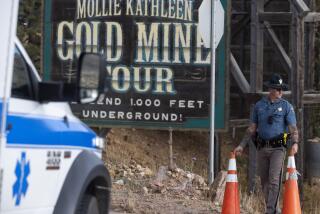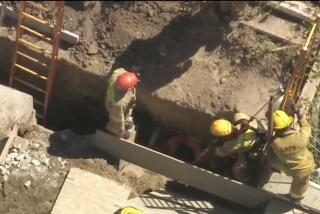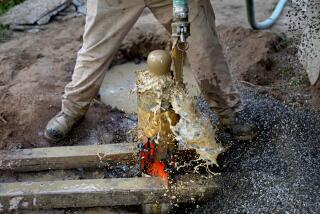Buried Driller Probably Died Within Minutes : Accident: His body is recovered after a 23-hour effort to rescue him. He was trapped when a well being dug in Bell collapsed.
- Share via
A veteran driller trapped in a collapsed pit at a well-digging site in Bell probably died within moments of the accident, before a 23-hour effort to free him was mounted, officials said Wednesday after finding his body.
“There was no way we could have gotten to him in time,” said Capt. Bob Grafton of the Los Angeles County Fire Department. “He could not have lived longer than three minutes, maximum. It was probably less than that.”
Scores of rescuers worked all day Tuesday and through the night, removing dirt from the pit, hoping they would find 50-year-old Ken Stott of San Bernardino alive, miraculously saved by a pocket of air.
But a two-man team clad like coal miners reached Stott at 7:12 a.m., 34 feet underground, and 10 minutes later determined he was dead.
The rescuers stood silently at 9:43 a.m. as the wrapped body was hoisted into the misty morning air and turned over to coroner’s deputies.
Stott’s wife--who had been on the scene since Tuesday afternoon--emerged from a camper truck parked nearby about an hour later. She hugged police officers who had sat with her through the ordeal, then was driven away by a relative.
“We’re all in a state of shock,” said Robert C. Diamond, a vice president of Layne Western Co., the Kansas-based parent firm of the contractor that employed Stott. “Our main concern is for the family and the friends of Kenny Stott.
McCalla Bros. Pump and Drilling Co. of Chino was installing the 500-foot-deep well on a fenced lot for the Southern California Water Co., which wanted to supply additional water to the eastern section of Bell.
Stott had worked for the contractor for 11 years and was considered conscientious and highly experienced, Layne said. After he dug a pit so he could scrape debris off the well casing, its walls and bottom collapsed, burying him under eight feet of dirt and mud, Grafton said.
Stott apparently was standing above a subterranean cavern, the fire official said. “There was no way he could have known the cavern was there,” Grafton said. “There is no way you can survey underground like that.”
Diamond would not comment on statements by a McCalla Bros. employee Tuesday night that Stott had uncharacteristically violated policy by going into the hole without shoring up its walls first, perhaps to save time.
“We don’t know yet what was happening so I can’t tell you what mistakes might have been made,” he said. “There are a lot of things to piece together.”
Eric Gottlieb, who was assisting Stott when the accident occurred, told reporters that he tried to dig his supervisor out of the pit, first with a backhoe, then with his hands. Gottlieb said he had to scramble out of the hole to keep from being buried himself.
The Fire Department brought in a 36-foot-long, six-foot-wide steel tube that was placed over the spot where Stott was buried to provide shoring. Members of the department’s urban search and rescue team then were lowered into it, along with volunteers.
The tube then was hammered farther down as they removed dirt from the inside.
Late Tuesday night, a massive vacuum machine was brought in to suck the dirt out faster, but it did not work as well as hoped, rescuers said, because the soil was packed tighter than they had thought.
Capt. Wayne Ibers, a leader of the rescue team, said the operation was the largest attempted by the special unit since it was formed about a year ago, primarily to execute difficult rescues during a major earthquake.
Those who did the digging at the Bell site, he said, worked in 10- or 15-minute stretches and were rotated periodically, so weariness and emotional strain could be kept at a minimum.
“We try not to get too high or too low,” Ibers said. “They did an excellent job.”
More to Read
Sign up for Essential California
The most important California stories and recommendations in your inbox every morning.
You may occasionally receive promotional content from the Los Angeles Times.













